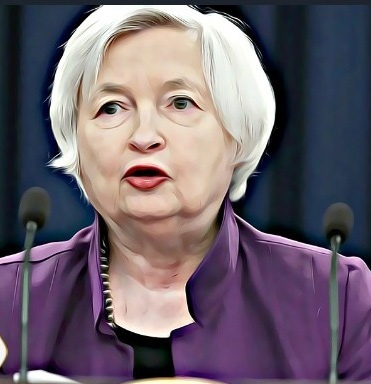Das FOMC (Federal Open Market Committee) der amerikanischen Zentralbank hat zwei Tage getagt (25.7.+26.7.2017) und ist zum Schluss gekommen, die Zinsen unverändert zu lassen. Gold ist mit Bekanntgabe des Ergebnisses aus der zweitägigen Sitzung leicht nach oben gegangen, war gegen 21 Uhr MEZ bei 1256 $/oz. Der Goldpreis in Euro bewegte sich um die 1074 €/oz.

Inflation kurz unter 2 %
Die Inflation sei kurz unter 2% und die Arbeitslosenrate sei leicht zurück gegangen, aber es sei noch nicht an der Zeit, die Zinsen weiter zu erhöhen. Wann dies der Fall sei, dafür wurde noch nicht einmal ein Ansatz genannt, nur vage Formulierungen a la „Wir werden die Märkte weiter beobachten und achten auf Inflation und das Ziel der Vollbeschäftigung“. Daraus könnte man den Schluss ziehen, dass so schnell erstmal keine Zinsen erhöht werden.
Kauft die FED zukünftig weniger Anleihen?
Allerdings hat die FED angekündigt, dass man bald damit beginnen werde, den Bestand an Anleihen nicht mehr in der gleichen Geschwindigkeit aufzubauen. Hier wird sich Präsident Trump also darauf gefasst machen müssen, dass die Finanzierung der USA zukünftig etwas schwieriger werden könnte. Bisher hatte die FED vor allen Dingen US-Staatsanleihen in immensen Summen aufgekauft und damit den US-Haushalt finanziert.
Was heißt das für den Goldpreis?
Geht es rein nach den Zinsen, hat man früher gesagt: Niedrige Zinsen sind gut für den Goldpreis, da dann die Anlagealternativen fehlen. Allerdings muss man auch die geopolitische Gesamtsituation betrachten: Aktuell gibt es zahlreiche Krisenherde auf der Welt, einen unberechenbaren US-Präsidenten, von dem niemand weiß, ob er die volle Amtsperiode auch im Amt verbringt und eine noch nie dagewesene Staatsverschuldung vieler westlicher Staaten. Dazu zahlreiche Probleme auch in Europa: Von unterfinanzierten Banken über verschuldete Staaten bis hin zu Austrittskandidaten aus der EU. Alle diese Probleme dürften tendenziell zur Flucht in Gold führen, sodass die meisten Analysten auch weiterhin positiv für eine Goldpreisentwicklung nach oben votieren und sich nur in der Höhe nicht einig sind.
Historisch betrachtet, war es auf lange Sicht noch nie unvernünftig, sein Vermögen durch Kauf von Gold gegen Risiken abzusichern. Dabei ist es sekundär, ob es Goldbarren oder Goldmünzen sind. Bei Anlagegold, welches so oder so kurz über dem reinen Goldpreis erworben wird, ist die Ausgestaltung sekundär. Wichtiger ist, dass man es kauft.
Wortlaut der Verkündigung aus dem FMOC vom 26.7.2017
Information received since the Federal Open Market Committee met in June indicates that the labor market has continued to strengthen and that economic activity has been rising moderately so far this year. Job gains have been solid, on average, since the beginning of the year, and the unemployment rate has declined. Household spending and business fixed investment have continued to expand. On a 12-month basis, overall inflation and the measure excluding food and energy prices have declined and are running below 2 percent. Market-based measures of inflation compensation remain low; survey-based measures of longer-term inflation expectations are little changed, on balance.
Consistent with its statutory mandate, the Committee seeks to foster maximum employment and price stability. The Committee continues to expect that, with gradual adjustments in the stance of monetary policy, economic activity will expand at a moderate pace, and labor market conditions will strengthen somewhat further. Inflation on a 12-month basis is expected to remain somewhat below 2 percent in the near term but to stabilize around the Committee’s 2 percent objective over the medium term. Nearterm risks to the economic outlook appear roughly balanced, but the Committee is monitoring inflation developments closely.
In view of realized and expected labor market conditions and inflation, the Committee decided to maintain the target range for the federal funds rate at 1 to 1-1/4 percent. The stance of monetary policy remains accommodative, thereby supporting some further strengthening in labor market conditions and a sustained return to 2 percent inflation.
In determining the timing and size of future adjustments to the target range for the federal funds rate, the Committee will assess realized and expected economic conditions relative to its objectives of maximum employment and 2 percent inflation. This assessment will take into account a wide range of information, including measures of labor market conditions, indicators of inflation pressures and inflation expectations, and readings on financial and international developments. The Committee will carefully monitor actual and expected inflation developments relative to its symmetric inflation goal. The Committee expects that economic conditions will evolve in a manner that will warrant gradual increases in the federal funds rate; the federal funds rate is likely to remain, for some time, below levels that are expected to prevail in the longer run. However, the actual path of the federal funds rate will depend on the economic outlook as informed by incoming data.
For the time being, the Committee is maintaining its existing policy of reinvesting principal payments from its holdings of agency debt and agency mortgage-backed securities in agency mortgage-backed securities and of rolling over maturing Treasury securities at auction. The Committee expects to begin implementing its balance sheet normalization program relatively soon, provided that the economy evolves broadly as anticipated; this program is described in the June 2017 Addendum to the Committee’s Policy Normalization Principles and Plans.